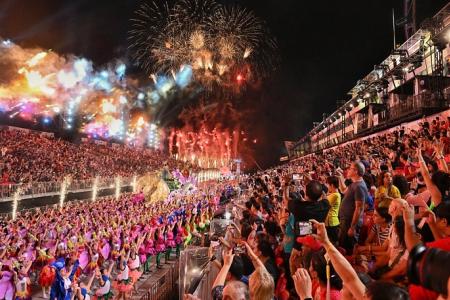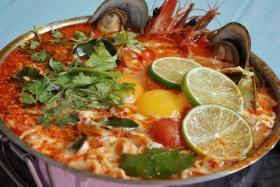Singapore-Malaysia to nominate Chingay parade to Unesco list
Singapore and Malaysia will be jointly nominating the Chingay parade to be inscribed on Unesco’s intangible cultural heritage list.
The National Heritage Board (NHB) said on Nov 5 that the nomination was jointly decided by both countries, which have Chingay-practising communities in Singapore, Johor Bahru and Penang.
“Chingay reflects the shared heritage of both countries, celebrates our connected cultures, and continues to be actively practised in both countries today,” said NHB.
It added that the nomination, set to be submitted in March 2025, will commemorate the 60th anniversary of bilateral relations between Singapore and Malaysia.
NHB and the People’s Association (PA) will be working with Malaysia’s Ministry of Tourism, Arts and Culture and Department of National Heritage.
Intangible cultural heritage refers to traditions or living expressions that are inherited and passed on between generations, such as performing arts, social practices, rituals and festive events.
Chingay, which takes place in Singapore as an annual street parade in celebration of Chinese New Year, has its roots in religious festivals devoted to Taoist deities such as Tua Pek Kong and Mazu.
According to NHB’s heritage resource portal Roots.gov.sg, it is believed that these festivals and processions were brought to Penang, and subsequently Singapore, by migrants from southern China in the early 1800s.
The portal adds that Chingay is derived from the Chinese word zhuangyi, which means “the art of costume and masquerade” in Hokkien.
The modern Chingay parade in Singapore – a multicultural affair organised by PA – was first held in 1973.
Founding prime minister Lee Kuan Yew had suggested that the parade could be staged to compensate for the 1972 ban on the Chinese New Year custom of lighting firecrackers to ward off evil spirits.
Speaking at a community float-making event at Nee Soon South Community Club on Nov 5, Minister for Culture, Community and Youth Edwin Tong said that Chingay, as a living heritage, has changed how it is celebrated over the years.
Today, it “reflects Singapore’s multicultural, diverse identities, our different backgrounds coming together, (and) our multiracial society”, he said, adding that taking part in the preparations and rehearsals for the parade have over the years given Singaporeans a sense of identity and a connection to the parade.
In February, Malaysian news publication The Star reported that the Chinese communities in Malaysia had mooted the idea of jointly nominating Chingay with other countries that observe the festival for Unesco’s list.
In Singapore, the Chingay parade was also on a March 2022 shortlist of 10 potential nominations to Unesco’s intangible cultural heritage list.
The list also included the Thaipusam festival, birthing traditions, Malay art form dikir barat, getai, the making and sharing of kueh, orchid cultivation, Peranakan beadwork and embroidery, traditional medical practices, and yusheng and its associated food heritage and social practices for celebrating Chinese New Year.
Malay dance veteran Osman Abdul Hamid, 62, first participated in the Chingay parade in 1978 as a performer, and later as a choreographer from 1992. What he has most enjoyed is interacting with audience members at the annual parade.
“I loved (it) when the parade was held in Orchard Road, and we were able to mingle with the crowd and get them to dance with us,” he said.
Mr Osman, who in December 2023 received a Cultural Medallion for his contributions to Singapore’s arts, said he has relished opportunities to work with artists of different cultural backgrounds for Chingay parades.
“When we create multicultural pieces, we get to understand each other’s individual cultures, and then come to an agreement on what would be the best approach for the dance,” he said.
Ms Kumudha M.R. Panneerchelvam, 41, a member of PA’s Narpani Pearavai, its Indian activity executive committees council, said that Chingay is special to her because it is an opportunity for the Indian community to come together and appreciate the cultures of various sub-ethnic groups.
On the joint Unesco nomination, she said it will open more doors for collaboration between Singaporean and Malaysian arts groups, and if it is successful, it will help foster unity and pride in younger Singaporeans for the country’s cultural heritage.
The joint nomination will be Singapore’s third submission for inscription on the Unesco Representative List of the Intangible Cultural Heritage of Humanity, following the successful inscription of hawker culture in December 2020, and the joint nomination of the kebaya in March 2023.
The outcome of the kebaya nomination – a joint bid by five South-east Asian countries including Brunei, Indonesia, Malaysia and Thailand – will be decided in December.
The Chingay bid’s result is expected in end-2026, at the earliest.
The NHB has its own inventory of intangible cultural heritage elements, which currently includes 106 entries such as silat and soya sauce making.
As at 2023, 80 multinational elements have been added to the Unesco representative list, which is made up of 611 entries from across the world that demonstrate the diversity of intangible cultural heritage and raise awareness about its importance.
Other multinational entries include craftsmanship of mechanical watchmaking and art mechanics – a joint nomination by Switzerland and France – as well as camel racing, practised in the United Arab Emirates and Oman.
Separately, the Singapore Botanic Gardens was inscribed on Unesco’s World Heritage List in 2015.
PA said on Nov 5 that the Chingay Parade 2025 will take place on Feb 7 and 8, and will be themed Joy.
There will be food-inspired floats, costumes and installations that celebrate shared meals and cherished memories, said the association, which added that 60 lion dancers will be among more than 4,000 performers from 150 organisations at the parade.
Tickets for the parade will go on sale from Nov 6, and more information is available at chingay.gov.sg
Get The New Paper on your phone with the free TNP app. Download from the Apple App Store or Google Play Store now


